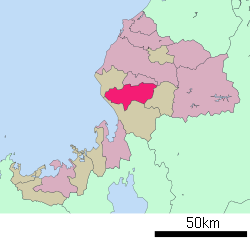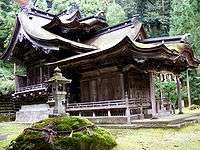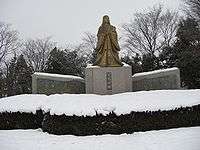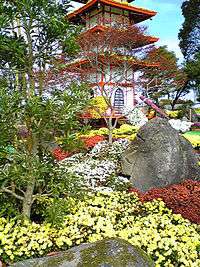Echizen, Fukui
| Echizen 越前市 | ||
|---|---|---|
| City | ||
| ||
 Location of Echizen in Fukui Prefecture | ||
 Echizen
| ||
| Coordinates: 35°54′N 136°10′E / 35.900°N 136.167°ECoordinates: 35°54′N 136°10′E / 35.900°N 136.167°E | ||
| Country | Japan | |
| Region | Chūbu (Hokuriku) | |
| Prefecture | Fukui Prefecture | |
| Government | ||
| • Mayor | Toshiyuki Nara | |
| Area | ||
| • Total | 230.75 km2 (89.09 sq mi) | |
| Population (August 2008) | ||
| • Total | 86,562 | |
| • Density | 375/km2 (970/sq mi) | |
| Time zone | Japan Standard Time (UTC+9) | |
| – Tree | Cherry blossom | |
| – Flower | Chrysanthemum | |
| Phone number | 0778-22-3000 | |
| Address |
1-13-7 Fuchu, Echizen-shi, Fukui-ken 915-8530 | |
| Website | City of Echizen | |
Echizen (越前市 Echizen-shi) is a city located in Fukui Prefecture, Japan.
As of August 1, 2008, the city has an estimated population of 86,562 and a population density of 375 persons per km². The total area is 230.75 km².
The modern city of Echizen was established on October 1, 2005, from the merger of the city of Takefu, and the town of Imadate (from Imadate District); although the Echizen Basin has been an important regional center for over 1,500 years. It has many former castle sites and prehistoric archeological sites. Echizen is known for its shrines and temples – well over 300. For a year it was the home of Murasaki Shikibu, author of The Tale of Genji. Her father was governor of Echizen Province in the Heian period.
History
Yamato period
During the Yamato period, the area from Tsuruga to Niigata was a kingdom called Koshi. In 507, during a succession crisis, a ruler from the Ajimano area of Echizen ascended the chrysanthemum throne to become the 26th emperor of Japan, Keitai, founding a new imperial dynasty. At that time, the Echizen basin began to develop economically and culturally.
Nara period
The Kingdom of Koshi was divided into three provinces, Echizen, Etchū, and Echigo. Echizen Province grew into an important military base guarding the capital provinces from the North. The area that would become Echizen city served as the gateway to the Hokurikudō road, and a government was established at Echizen-Fuchū (present-day Fuchū neighborhood). The area grew and became an important political, economic, and cultural center. During this period, the poet Nakatomi no Yakamori was exiled to Echizen, where he wrote some of his 40 poems collected in the Man'yōshū, including his love letters to Sanuno Otogami no Otome. Another famous Man'yōshū poet, Ōtomo no Yakamochi, wrote many pieces about Echizen. Their poems can now be found in Echizen no Sato, a garden within the city.
Heian period
The provincial governor of Echizen, Fujiwara no Tametoki, was the father of the celebrated author Murasaki Shikibu. Lady Murasaki left her hometown of Heian-kyō only once in her life, to go to Echizen with her father. She stayed for just over one year, and then returned home to marry Fujiwara no Nobutaka. Her experiences in Echizen are said to have had a major influence on her greatest work, The Tale of Genji, and many place names from Echizen appear in her stories and poems.
Nanboku-chō period
Echizen-Fuchū remained an important military center. A number of battles were fought, and numerous castles were built and raised during this time. Shiba Takatsune, the Constable of Echizen, supported the Northern Court during the war, and fought with Yoshisada Nitta in the Battle of the Hino River. Shiba lost the battle, and his castle was taken by Nitta. Shiba fled north to Asuwa Castle in Fukui. Nitta pursued him but was defeated and killed by Shiba in the Siege of Kuromaru. Shiba returned to Echizen-Fuchū and conquered both Fuchū Castle and Ōtaki Castle. The outcome of the war between the Northern and the Southern Imperial Courts was decided around the Fuchū area. Today a plaque marking the site of Shinzenkōji Castle can be seen at Shōgaku-ji temple in Echizen, and remains of other castles can be found throughout the city.
Muromachi period
Shiba Takatsune's victories in the Nanboku-chō period allowed him to become a powerful daimyō, independent of the position given to him by the shogunate. He changed his name from Shiba to Kuratani, and control of Echizen became hereditary, remaining in his family instead of reverting to the shogunate. He made his home around the Ajimano area of Echizen city.
Sengoku period
Echizen prospered under the leadership of the Asakura daimyōs, who had moved the capital of the province from Echizen-Fuchū to Ichijōdani, near Fukui city. Under Asakura Yoshikage, Echizen enjoyed peace and stability far greater than the rest of Japan during the chaotic Warring States period, thanks to his negotiations with the Ikkō-ikki. As a result, Echizen became a refuge for people fleeing the violence further south.
When Oda Nobunaga invaded Echizen, he completely defeated the Asakura clan, burning Ichijōdani to the ground and re-establishing the provincial capital at Echizen-Fūchu. To maintain the peace and keep the Ikkō-ikki under control, he divided Echizen-Fuchū among his generals Fuwa Mitsuharu, Sassa Narimasa, and Maeda Toshiie. These three were known as fuchū sanninshū (府中三人衆 lit. "The Fuchū Three") for their cooperation in governing the area. Part of Sassa Narimasa's castle, Komaru Castle, still stands today. Maeda Toshiie took residence in Echizen-Fuchū Castle, on the current location of the Echizen city hall. Fuwa Mitsuharu took charge of Ryūmon-ji Castle, whose stone foundations and parts of the moat can be seen today at Ryūmon-ji temple.
Edo period
After the Battle of Sekigahara, Yūki Hideyasu became head of Echizen Domain.[1] The provincial capital was moved for the last time, from Echizen to Fukui. The Matsudaira clan remained in control of the area throughout the Edo period. Eventually Echizen Domain became known as Fukui Domain.
During this time, Honda Tomimasa, highly trusted by Tokugawa Ieyasu, was appointed as Hideyasu's chief retainer. Honda received a small piece of land and became governor of Echizen-Fuchū. Devastated by years of war, Echizen-Fuchū had lost its castles, roads, and buildings, and Honda is responsible for a major reconstruction of the area. He rebuilt the roads, walls, and buildings, as well as irrigation systems connected to the Hino river. Honda started the industries that still make up Echizen's base economy: blades, textiles, and industrial machinery. The Honda clan ruled the Echizen-Fuchū area for nine generations, until the Meiji Restoration. Their graves can be seen at Ryūsen-ji temple in Echizen.
Meiji period
According to an ancient Min'yō (folk song) called "Saibara", the area of Fuchū was known as Takefu during the Nara and Heian periods. In the second year of Meiji (1869), this ancient name was restored. In 1889 the town of Takefu was officially established.
During the Meiji Restoration, the daimyō system of the Edo period was abolished and the daimyōs were reorganized into the kazoku class of nobles. However, Honda, being only a retainer and not a daimyō, was moved into the lower shizoku class. In 1870 the outraged Honda clan rebelled against the Meiji government in protest against this demotion. This riot is known as the Takefu Soudou. In 1879 Honda Sukemoto was promoted to kazoku, and finally to danshaku in 1884.
Shōwa and Heisei periods
In 1948 Takefu city was officially established. During the next 11 years, Takefu absorbed seven neighbouring villages and greatly increased in size and population.
On September 20, 1949, an incident known as the Takefu Jiken took place. At around 5 am the District Court and the District Public Prosecutor's Office caught fire. Within an hour, all of the court records and documents were destroyed. The fire was blamed on arson related to gang activity, and scenes from the movie Battles Without Honor and Humanity are said to be reminiscent of this incident.
On October 1, 2005, Takefu and Imadate were merged to create Echizen City. The newly created city became home to the largest number of cultural assets in Fukui Prefecture. Today Echizen has several large electronics and apparel factories, but it is known for the large number of small businesses that flourish there; it is said that the local joke is that everyone in town addresses each other as "shacho" ("company president"). Echizen is home to a small community of Brazilians, who mostly work in ceramic capacitor factories, and to a smaller Chinese community, largely linked to the textile industry. A number of foreign English teachers also live in Echizen, teaching at local high schools, middle schools and elementary schools.
Transport
Rail
Takefu Station, the city's central railway station, is a major stop on the JR West Hokuriku Main Line. The city also serves as a terminus for the Fukui Railway Fukubu Line.
The Hokuriku Shinkansen, currently under construction, will ultimately extend from Tokyo via Nagano and Kanazawa to Osaka.
Bus
Regular services are provided primarily by Fukui Railway.
Roads
The Hokuriku Expressway provides access through the city to the north and south; the Takefu Interchange is located within the city limits.
National Route 8, also known as the Fukui Bypass, runs parallel to the Hokuriku Expressway through the city. National Route 305/365 also runs through the city.
Famous places
Shrines

- Soja Shrine (総社大神宮)
- Ōshio Hachiman Shrine (大塩八幡宮): A national Important Cultural Property.
- Omushi Shrine (大虫神社)
- Hino Shrine (日野神社)
- Ajimano Shrine (味真野神社)
- Okafuto Shrine and Ōtaki Shrine (岡太神社、大瀧神社)
Temples
- Gekkō-ji (月光寺)
- Hoyama-ji (帆山寺)
- Inshō-ji (引接寺)
- Ryūsen-ji (龍泉寺)
- Ryūmon-ji (龍門寺)
- Kongō-in (金剛院)
- Reisen-ji (霊泉寺)
- Gōshō-ji (豪摂寺)
- Jōfuku-ji Garden (浄福寺庭園)
Parks

- Murasaki Shikibu Park (紫式部公園): Built in honor of Murasaki Shikibu, author of The Tale of Genji, who lived in Echizen for a year with her father, Tametoki Fukuwara, the governor of Echizen. The park was modeled after a nobleman's residence in the Heian period. A statue of Murasaki Shikibu stands in the park, gazing in the direction of Kyoto.
- Ajimano Park (味真野苑)
- Kakyō Park (花匡公園)
- Kojirō Park (小次郎公園)
- Rozan Park (廬山公園): Built on top of Murakuni mountain, this park overlooks the entire plain from Takefu to Fukui city. Mt. Hakusan can easily be seen from here on a clear day. This vantage point also provides a night view of Echizen, Sabae, and Fukui cities.
- Echizen no Sato (越前の里), in which are found:
- Man'yōkan (万葉館)
- Chrysanthemum Exhibition Hall (万葉菊花園)
Castles and forts
As an important military center for centuries, Echizen contains the sites of a number of former castles. Some remains, including former gates, sections of moats, and mounds, can be seen in the city. Archaeological digs have also uncovered roof tiles, tools, weapons, and other artifacts at these sites.
- Kongōin Castle (金剛院城)
- Komaru Castle (小丸城)
- Kuratani Castle (鞍谷御所)
- Fuchū Castle (府中城)
- Mount Buei Castle (武衛山城)
- Gyōjidake Castle (行事岳城)
- Ōtaki Castle (大滝城)
- Ryūmonji Castle (龍門寺城)
- Shinzenkōji Castle (新善光寺城)
- Honpo Jin'ya (本保陣屋)
- Shimomagara Magara Yakata (真柄館)
- Shirosaki Jin'ya (白崎陣屋)
- Tokuma Magara Yakata (真柄館)
Other

- Kura-no-Tsuji (蔵の辻): Echizen's historic area in central Takefu is full of old warehouses with white painted walls. Outdoor concerts and festivals often take place in the open square in the center of this neighborhood.
- Takefu Town Hall Museum (武生公会堂記念館)
- Teramachi-dōri (寺町通り)
- Birthplace of Chihiro Iwasaki (いわさきちひろの生家)
- Takefu Knife Village (タケフナイフヴィレッジ)
- Usuzumi Cherry Tree (薄墨桜)
- Ōjigaike (皇子ケ池)
- Washi no Sato (和紙の里): This neighborhood is dedicated to the traditional craft of Japanese papermaking.
- Japanese Paper Plaza (和紙の広場)
- Papyrus Center (パピルス館): This building holds information and a workshop about the art of traditional Echizen paper.
- Cultural Museum of Paper (紙の文化博物館)
- Udatsu Craftsman's Studio (卯立の工芸館)
- Yanagi Falls (柳の滝)
- Minowaki no Tokimizu (蓑脇の時水): This waterfall was selected as one of Japan's 100 best scenic views.
- Uno Tea Ceremony Museum
Festivals and events

Specialty products
Local foods
- Buckwheat noodles soba and oroshisoba (with grated daikon)
- Echizen crab
- Habutae maki: sweet bean paste and mochi covered in sponge cake
- Satsukigase: a Japanese sweet
- Mizuyōkan: a firm sweet made from azuki beans
- Kenkera: an old-fashioned Japanese sweet
- Baigetsu senbei: a rice cracker dusted with sugar
- Manshō beans
Traditional crafts
- Echizen washi
- Echizen cutlery
- Echizen tansu
- Traditional roof tiles
- Chrysanthemum dolls
Notable people from Echizen
- Akiyama Tokuzō, imperial chef
- Murasaki Shikibu, novelist, poet, author of one of the earliest novels in human history
- Keizan, one of the founders of Sōtō Zen Buddhism
- Hiromoto Watanabe, governor of Tokyo and founder of Tokyo University
- Kinya Machimura, businessman and statesman
- Chihiro Iwasaki, children's book illustrator
- Ichibei Iwano, a paper maker and Living National Treasure
- Ryoichi Ikegami, manga artist
- Michiko Neya, voice actress
- Makara Naotaka, samurai
- Sasaki Kojirō, swordsman
- Machi Tawara, writer, translator, and poet
- Masatoki Minami (Fumitoshi Koshinaka), travel writer and railway photographer
- Akihisa Makida, professional baseball player for the Rakuten Golden Eagles
- Nobutoshi Shimada, professional baseball player for the Nippon-Ham Fighters
Cityscape

Sister cities
- Takayama, Japan
- Motosu, Japan
- Montevallo, Alabama, USA
References
- ↑ Appert, Georges. (1888). "Matsudaira" in Ancien Japon, pp. 70; compare Papinot, Jacques Edmond Joseph. (1906). Dictionnaire d'histoire et de géographie du Japon; Papinot, (2003). Nobiliare du Japon, pp. 29-30; retrieved 2013-3-26.
Further reading
- Griffis, William Elliot (1876). The Mikado's Empire.
External links
| Wikimedia Commons has media related to Echizen, Fukui (city). |
 Echizen travel guide from Wikivoyage
Echizen travel guide from Wikivoyage- Echizen City official website (Japanese)
- Information for visitors of Echizen city (Echizen City) (English)
- Products and Directions (Echizen City) (English)
- Annual Festivals (Echizen City) (English)
- Castle Sites (Japanese)
